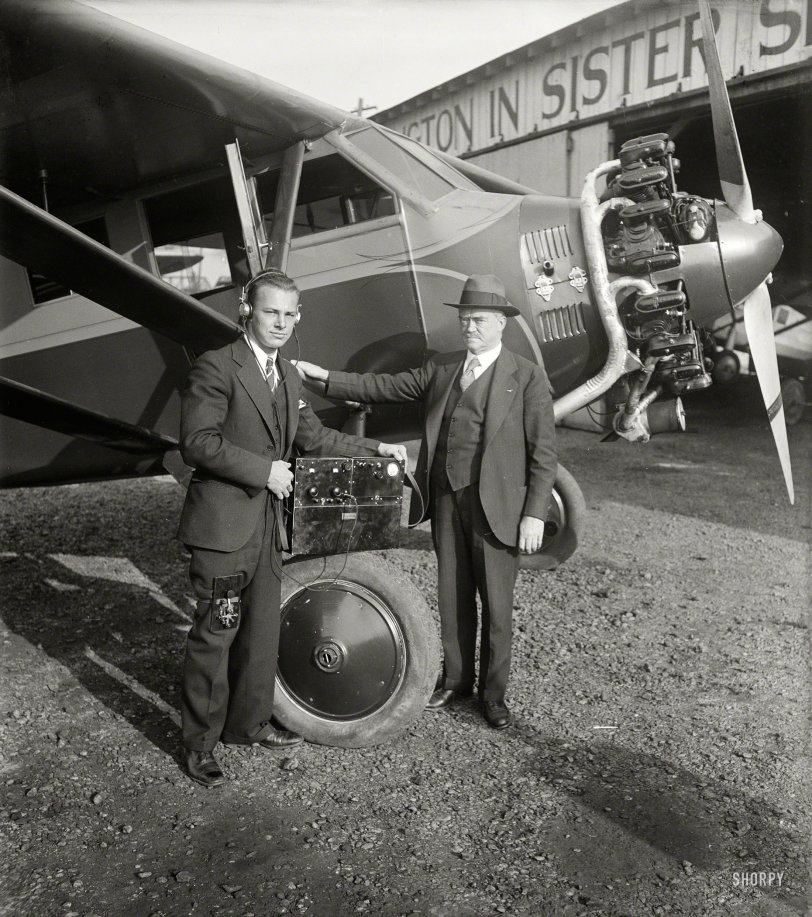


Framed or unframed, desk size to sofa size, printed by us in Arizona and Alabama since 2007. Explore now.
Shorpy is funded by you. Patreon contributors get an ad-free experience.
Learn more.

- Details, Details
- What's that building to the left of the tower?
- Coal Barges
- Bromo-Seltzer
- Inner harbor
- The Basin
- What a headache!
- Giant stepladder?
- Baldwin 62303
- Baldwin VO-1000
- Cold
- No expense spared
- Tough Guys
- Lost in Toyland
- And without gloves
- If I were a blindfolded time traveler
- Smoke Consumer Also Cooks
- Oh that stove!
- Possibly still there?
- What?!?
- $100 Reward
- Freeze Frame
- Texas Flyer wanted
- Just a Year Too Soon
- WWII -- Replacing men with women at the railroad crossing.
- Yes, Icing
- You kids drive me nuts!
- NOT An Easy Job
- I wonder
- Just add window boxes
Print Emporium
Airplane Mode: 1929

Dec. 5, 1929. Ignition interference from airplane engines on aircraft is largely a myth according to C. Francis Jenkins, Washington, D.C., inventor who has designed a radio receiving set which he says does not pick up noises from a flying power plant. In this photograph is shown Mr. Jenkins (right) and his laboratory assistant.
Video pioneer Francis Jenkins, seen here last week, and an anonymous protege who has a telegraph key strapped to his leg. By our reckoning this counts as early mobile texting. Harris & Ewing Collection glass negative. View full size.
Stinson Detroiter
According to newspaper accounts Jenkins was an experienced pilot and owned a Stinson Detroiter monoplane which he used for his experiments. I'm no expert but compared to other images of Stinson Detroiters on the web, this appears to be that plane.
C.F. Jenkins was also seen in previous Shorpy post Listening to Mars: 1924.
Ryan M2 ?
This model of the Ryan monoplane was the basis for the highly modified Spirit of St. Louis, designated model NYP, which stood for "New York to Paris".
Washington Airport
Near 14th St. Bridge, Arlington VA. The sign reads "Fly over Washington in Sister Ship to Spirit of St. Louis." That may well refer (loosely) to the plane pictured.
36 years later
I was a radio/radioteletype operator in the US Army serving in Germany. The only keys we had were the type that clipped to the thigh such as this one did - to this day, I do not believe I could use a telegraph key that is flat on a desk or table.
To all the guitarists out there
Take a look at the jack plug on the cord running to his headphones. It is the 1/4" plug that became the defacto standard for guitar cords. BTW, we called headphone "cans" in those days, but today, "cans" has an altogether different meaning.
Where was this taken?
Can anybody figure out where this was taken and what was written on the hanger? The fragment of the lettering visible on the hanger ("TON IN SISTER S" or perhaps "GTON IN SISTER S") is intriguing.
FAA Violation
Thrown off the plane for not turning the electronics off during takeoff/landing?
Key strapped to leg
That's the standard method of securing a key for use in the field absent a table or desk.
























On Shorpy:
Today’s Top 5